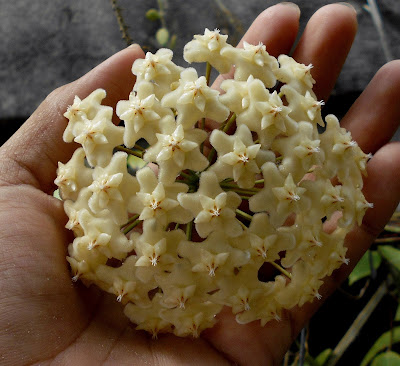A white, 'salty' Hoya
About a decade ago, some plants of a supposedly albinistic Hoya pubicalyx became available from a few orchid peddlers in the province of Quezon, and were being offered for rather exorbitant prices. Not too long thereafter, the plants were visited in its area of discovery by George Mendoza, a plant collector, and the plants he collected were sent abroad, which formed the bulk of the plants eventually propagated in Thailand, Sweden, and the US. Meanwhile, the plants were very rarely seen in its country of origin.
I have been to the type locality of this species, and contrary to what was given in the protologue, the plants were not found in the town of Mauban, but in Real. Here also is the locus classicus for Begonia polilloensis. The area where Hoya celata was found in 2010 is characterized by cliffs facing the sea but is now heavily degraded due to a road being constructed, although recent visits proved that plants still persist, particularly on the higher reaches. However, since this is also the very same spot where H. pubicorolla subsp. anthracina was originally found, I am not sure which plants I saw as all the hoyas I found on at least two occasions were sterile. The proximity of these plants to the sea may also mean that sea sprays may be a common occurrence but is tolerated.
Hoya celata is easily distinguished from H. pubicalyx (apart from its color) by the corolla tips that bend backwards. There are other traits as mentioned by the authors, but this is the most easily observed. The leaves of H. celata are of a lighter color than those of H. pubicalyx, and does not exhibit the pale green/silvery splashing usually seen in the latter.
Like H. pubicalyx, this is an easily grown species but seems to tolerate drier conditions better which should come as no surprise considering its habitat of dry cliffs facing the sea. I believe this to be a rather slow to difficult species to grow in temperate climates due to its strictly tropical requirements. It is a moderate grower in my place but does not flower as often as I like it to. One thing I also noticed, but this time on a positive note, is that the plants don't seem to be particularly prone to aphid and mealybug attacks. I must admit to subjecting many of my hoyas to some benign neglect, but the celatas remain as they are, healthy and free of pests. The flowers are fragrant both day and night, and the blooms remain in good condition for three days before falling off.
Recent years have seen these plants becoming more available, though still with not much regularity. Apart from nursery-grown plants, cuttings can also be had from private collectors, though there really aren't many (the plants, not the collectors 😄).






Comments
Post a Comment